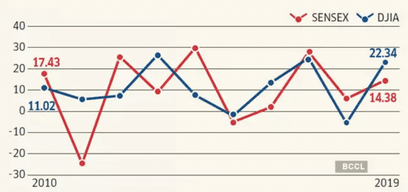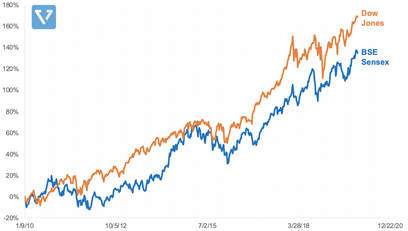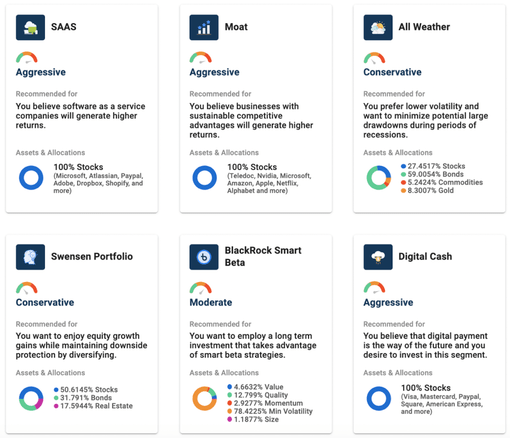A Beginner’s Guide to Investing Internationally from India

Last Updated: 10th December 2022 - 09:31 pm
Ace investor & co-founder of First Global, Shankar Sharma’s global portfolio was up 70% in 2019. His Indian portfolio, by his own admission, didn’t do nearly as well. He attributed this performance to this strategy of diversifying across countries. “If you have single-country, single-asset exposure, you are fated to lose sooner or later, irrespective of what the government or fund managers tell you,” he says. In the post-Covid era, he’s gone to highlight how Indians must expand their horizons beyond domestic shores. “The Indian market has delivered zero, in fact, negative returns in dollar terms,” Sharma adds.
In 2020, Indians are now eyeing international investments in larger numbers than ever before. There are several factors fueling this interest. A number of US stocks, including Apple, Amazon, and Facebook, have exhibited steady upward growth, making them attractive alternatives to Indian stocks. In contrast, investing in the Indian economy has been a mixed experience in 2020 and prior. Even before the coronavirus pandemic, the International Monetary Fund (IMF) lowered India’s economic growth forecast from 6.1% to 4.8% for 2019-20. Naturally, the numbers became more concerning as markets tanked March onwards. Such developments, coupled with a broad increase in interest, are paving the way for international investments from the Indian investor community. If you’re looking to get started with investing internationally from India, here’s a handy guide covering the what, the why, and the how.
Why should you invest in US Stocks?
“What’s interesting about US stocks is that you not only get exposure to the United States but also to the world, as many companies have global operations but are listed there.”This statement from Viram Shah, co-founder and CEO of Vested Finance, highlights one of the major advantages provided by investment opportunities in the US market. Portfolio diversification is one of the many reasons why investing in US stocks is a helpful addition to your portfolio. US indices such as the NASDAQ and S&P 500 have very little correlation with Indian indices such as the Sensex – 0.36 over the past decade, to be precise. From a diversification perspective, this makes investing internationally an essential task for Indian investors.

Figure 1: Dow Jones Industrial Index vs Sensex. Annual returns 2010-2019. Source: ET
Another advantage that the US stocks have over Indian stocks is the currency in which they trade. The US dollar is up 6% against the rupee this year alone. The US markets have also proved to be more stable than Indian markets in the long run.
And when you focus on returns, international investments typically outperforms domestic stocks investments. The DJIA has beaten the Sensex over 3-year, 5-year, and even 10-year periods.
Perhaps more importantly, despite this performance, the Dow Jones is at a lower price-to-earnings value (20.53) than the Sensex (25.01) as of Feb 2020. At the same time, dividend yield remains higher in US markets.

Figure 2: Returns comparison between Dow Jones and Sensex (INR based), from January 2009 – Dec 2019
So, how can you get started?
How to start investing internationally from India
Investing in international markets may seem overwhelming at first. But it is 2020, and fortunately, the process has been significantly simplified for those who are keen on diversifying their portfolios. There are many ways by which you can go about investing internationally:
- You can purchase mutual funds that invest in international stocks
- You can invest in Exchange Traded Funds (ETFs) using an investing account. ETFs are different from mutual funds as they are listed and traded just like stocks and tend to have lower expense ratios
- Or, you can directly invest in international stocks listed on international exchanges using dedicated platforms.
How to invest in US stocks with 5paisa
5paisa through Vested platform facilitates international investing by offering both direct investments in stocks and ETFs and investments through curated portfolios. Investors can open an account through a paperless process with no minimum balance and take advantage of commission-free investing. All they need to provide is their:
- PAN card number and copy, and
- Proof of address
Here’s how the two investment options work:
- Direct investments by opening a US brokerage account: To facilitate direct investments, we offer a dedicated platform where Indian investors can directly purchase stocks and ETFs in the US markets. This method lowers overall costs for the investor, but funds must be wired to the US. The Liberalisation Remittance Scheme (LRS) allows this, with the annual upper limit capped at $250,000 per person. We also offer fractional investing capabilities, lowering the barrier of entry for many
- Diversified investments into curated portfolios for varying risk profiles: Our platform, investors that want more advice on what to invest, can also invest in Vested’s proprietary curated portfolios. These portfolios are called Vests. Vests are curated for different risk profiles and are constructed with different themes in mind. Vests might be a great option for investors looking to expand their investments to international shores but wishing to retain a narrow focus on specific sectors or industries

How does Taxation work
International Exchange Traded Funds (ETFs) are treated as debt funds for taxation purposes. This means that to qualify as long-term holdings, you must keep them for three years. While the short-term capital gains tax rate is as per your applicable income tax slab, long-term capital gains tax is charged at 20% with indexation benefits.
For investors making direct investments in US markets, they are liable to pay taxes on both investment gains and dividend gains. Investment gains will be taxed in India only – where the tax liability is determined by the duration of their holdings. 24 months is the long-term capital gain threshold, with the rate of 20% with indexation benefit. Investments held less than 24 months will incur short-term capital gains tax, calculated according to applicable individual income tax slabs.
Dividends are taxed in the US at a flat rate of 25%. Thanks to the US and India’s Double Taxation Avoidance Agreement (DTAA) though, taxpayers can offset the income tax they’ve already paid in the US. Learn more about this topic here: how taxation works for Indians investing in US markets.
Investing Internationally from India: Closing Thoughts
International investments help you gain exposure to other markets. Geographical diversification can reduce country risk, including risk from negative events that might impact India’s domestic economy. Moreover, as mentioned earlier in this post, when you compare investing in Indian markets vs US markets, US stocks have historically exhibited lower volatility, higher returns, and higher international exposure.
- Flat ₹20 Brokerage
- Next-gen Trading
- Advance Charting
- Actionable Ideas
Trending on 5paisa
Disclaimer: Investment in securities market are subject to market risks, read all the related documents carefully before investing. For detailed disclaimer please Click here.
 5paisa Research Team
5paisa Research Team
 Sachin Gupta
Sachin Gupta